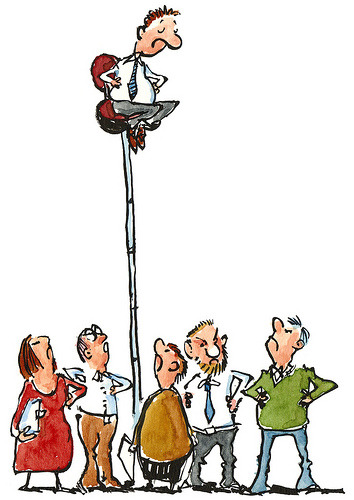The peculiar challenge of knowledge work is that so much of it takes place in our heads and out of sight. In contrast to the era of factory work, knowledge work is nowhere near as visible. You can’t discern the state of progress by looking at tangible output or product.

This poses a particular problem for managers, whose job it is to support their employees and enable progress. You can’t properly manage what you can’t see. Otherwise the result is directives and orders that don’t make sense, veering toward irrelevance and away from the reality of the situation. Leading blindly without understanding the status of projects and the context in which people are working makes as much sense as managing a production line without seeing the state and quality of a product as it is being assembled.
Show and Tell Your Work
The solution is to encourage and cultivate showing your work, or put another way, working out loud. Communicating what you’ve done is vital to moving things along, and it actually should be the other half of your job.
The benefits are clear. With transparency and communication of information, teams and organizations can improve productivity because they are able to manage operational efficiency. With the ability to see all the moving parts, you can figure out how to work better. Then, the opportunity opens up for improving planning and methods, collaborating and striving for more dazzling results, and having a common basis and drawing board to truly innovate together.
Why We Hide
The interesting thing about showing your work, though, is how resistant people — including both the managers and the managed — can be in implementing the practice. The underlying reason for this hesitation comes down to how managers hold people accountable, because it changes how people perceive the intent behind the effort to be more transparent.

Bad managers impede and inhibit progress in two ways. One is the traditional school of managing people that fails to deal with real progress at all. That school subscribes to the mistaken belief that management is about oversight and monitoring for the purpose of Big Brother-type control, thinking that you make things happen by paternalistic brute force.
The other approach is one of disengagement in order to keep the positive image of being liked, thinking that this lack of confrontation and involvement is what is necessary to keep the wheels greased. The crazy result is that one of out every two managers fail to keep people accountable.
Employees then feel resentful of losing autonomy and substantive feedback and become increasingly disengaged, feeling like useless cogs in the machine.

Such managerial failures in approach to accountability is thus why employees themselves can view transparency with such suspicion. As with personal relationships, there’s a difference between transparency for the purpose of engagement and open communication as opposed to for the purpose of coercive oversight. And transparency becomes futile when information goes nowhere or falls on deaf ears.
The Courage To Be Accountable
At the end of the day, both the managed and managers don’t want to feel vulnerable. For employees, transparency can seem a risky business of putting themselves out there, with the potential to look weak or ineffective or ignored, especially in situations with bad management. For managers, transparency and accountability means having difficult conversations, truly getting involved with their teams as people and their work, and getting used to the uncomfortable notion that management isn’t so much about control but support and facilitation.
Accountability does require visibility, but we should never treat people like faceless cogs in a machine. Working out loud should not produce more constraints and traps but more autonomy. If managers are doing their job of helping people make progress, people will want to show their work and together cultivate a vibrant company culture of openness, fruitful feedback, and deep engagement.
Liked this post? Subscribe to our free newsletter for more great content on management, productivity, and how to work better!
Images: [1] Shreyans Bhansali; [2] Frits Ahlefeldt-Laurvig; [3] Joel Ormsby>
